With my farmwork finished and my second Working Holiday Visa safely granted, it was time to hit the road again, and this time I had something totally different in mind; heading away from the beaches and into the outback of Central Australia. I wanted to see the real Australia; the red sand, the vast empty desert land, and of course, one of the most famous rocks in the world, Uluru (sometimes referred to as Ayers Rock). So from Adelaide I hopped onto a plane, and in two hours I was landing in Alice Springs, right in the middle of the country.
Alice Springs has a poor reputation, but there was something about the town which I really liked. I stayed in the Alice Springs YHA which, whilst it did attract some strange characters, was a lovely little hostel with a pool to relax besides, right in the centre of town, and which felt very safe and secure. Judging by the sounds drifting over the fence at night, it did seem that Alice could be chaotic after dark, but during the day I enjoyed wandering around; there were plenty of cute little independent shops and cafes, and on Sunday morning there was a market showcasing local arts, crafts and food.
Whilst in Alice Springs I took the opportunity to visit the wonderful Kangaroo Sanctuary that many will recognise from the BBC television series Kangaroo Dundee. The staff at the sanctuary rescue orphaned baby kangaroos found in their dead mother’s pouch at the side of the road. If possible, they are released back into the wild as adults, but if not, they live out their lives in this 50-acre sanctuary where they have plenty of space to live pretty much as they would out in the bush. In order to protect the kangaroos’ welfare, visitors are welcome only on one of the sanctuary’s sunset tours, where you’ll be picked up from Alice Springs and can meet the kangaroos during their natural rising time (they are nocturnal). You’ll be given the opportunity to cuddle a very young joey, swaddled in a pillowcase to mimic its mother’s pouch (the babies who meet the public have already had a lot of necessary human interaction to save their lives, and are therefore unlikely to be able to go out into the wild, so this doesn’t harm their development). The sanctuary staff work hard to educate locals and tourists about stopping to check dead kangaroos for babies, and they do a beautiful job of protecting these fantastic creatures. If you’re wanting to get up close with kangaroos in an ethical manner whilst in Australia, I cannot recommend this place enough.
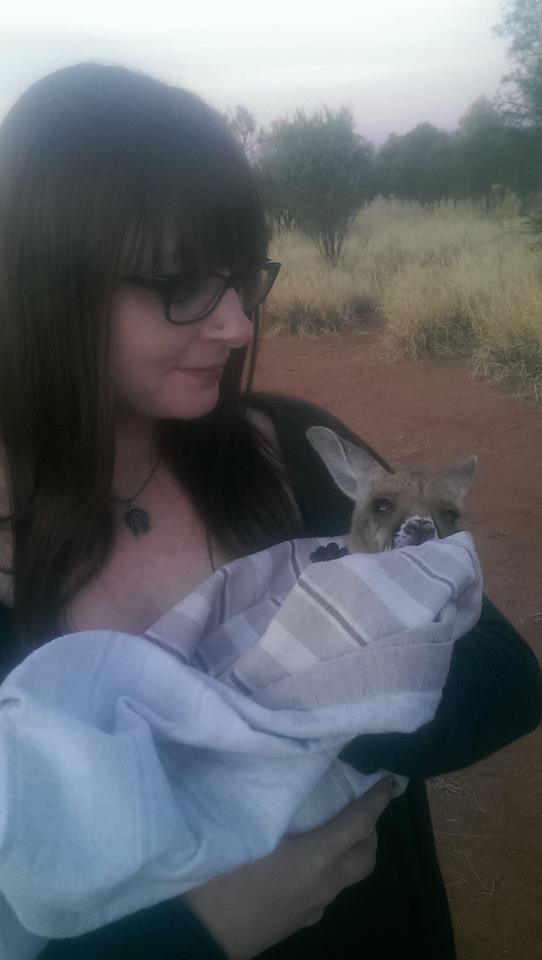
Cuddles with Charlotte, the orphaned baby kangaroo
As much as I could have happily moved into the sanctuary and stayed forever, I had come here for the rocks, so soon it was time to head out into the desert. A few years previously I had watched the movie Tracks, based on the true story of Robyn Davidson who walked across the Australian desert from Alice Springs to the Indian Ocean with just a few camels and her dog for company, and I was quite taken with the idea of camping in the outback under the stars. Most of the tour companies operating in the area offer this experience, and after a few recommendations from other travellers who had already done this trip, I settled on The Rock Tour.
My trip started with a very early morning pick-up from Alice Springs. Central Australia during the winter manages to be freezing at night, and hot during the day, so layers were definitely key in my weird get-up this morning – vest and shorts for later underneath jogging bottoms, several long-sleeved tops, and the big jumper and winter hat I’d bought in the op shop in Tanunda during my farmwork days. Our tour guide/driver Connor was very experienced and wisely knew to leave us all to snooze during the first part of the journey, stopping at a camel farm a couple of hours later as the sun was rising, where we could get some coffee, stretch our legs and start to wake up for the long day ahead. I think that camel farms are awful places – the camels are taken from the wild and “broken in” to give rides to tourists – so I left the rest of the group who were considering partaking and went to admire the beautiful creatures and soak up my first views of the red desert and the first rays of morning sun as I drank my coffee.

Poor camels.
Back on the road and suitably revived and ready to hit the outback, it was another few hours’ drive before we reached our first hiking spot – King’s Canyon, in the Watarrka National Park. By now the land was well and truly warmed up, and we stripped down, suncreamed up and made sure that our water bottles were full, before tackling the King’s Canyon Rim Walk. The hardest part of the hike was most definitely the first ascent, known colloquially as “Heart Attack Hill”, but the trek was worth it for the fantastic views of the stunning scenery.
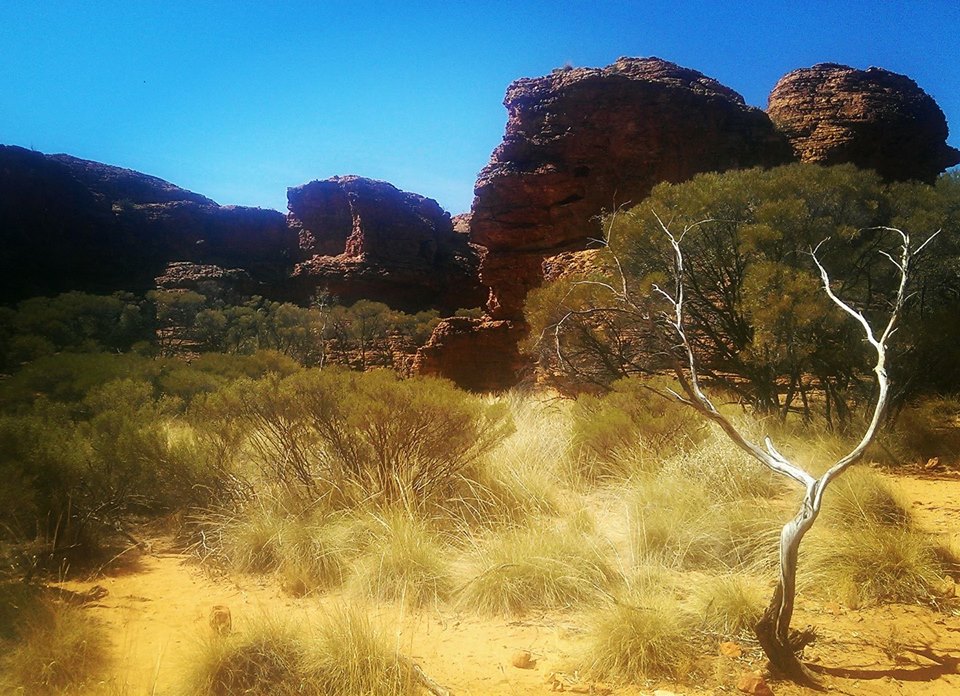


Once we’d finished our walk we had another long drive to reach our camp for the night. I knew that the distances involved in travelling Central Australia were vast, but experiencing it for myself really brought it home for me; mile upon mile of bush empty of anything apart from rocks and scrubby trees, and literally an hour or two could pass between meeting vehicles coming the other way. It was wild, beautiful, and truly unlike any landscape I’d ever seen before. We stopped along the way to pick up firewood to load on top of the bus for our camp later, and to buy some horrendously overpriced wine and beer at a roadhouse which loudly proclaimed itself to be the “last stop for booze before Uluru” before passing Mount Conner, also known as “Fooluru” from the early days of tourism in the area when its dome shape tricked visitors into thinking they’d reached the famous rock (it definitely had many on the bus reaching for their cameras!), and reaching our bush camp. This was as basic as you get when it comes to camping; no electricity and no shelter – just a firepit, a tap and a toilet seat placed on top of a hole into the ground inside a shack. Connor got the fire going and set to work cooking up a delicious rice and chilli meal for us (meat cooked separately – us vegans and vegetarians were very well catered for) whilst we perched on our rolled-up swags and chatted around the flames.
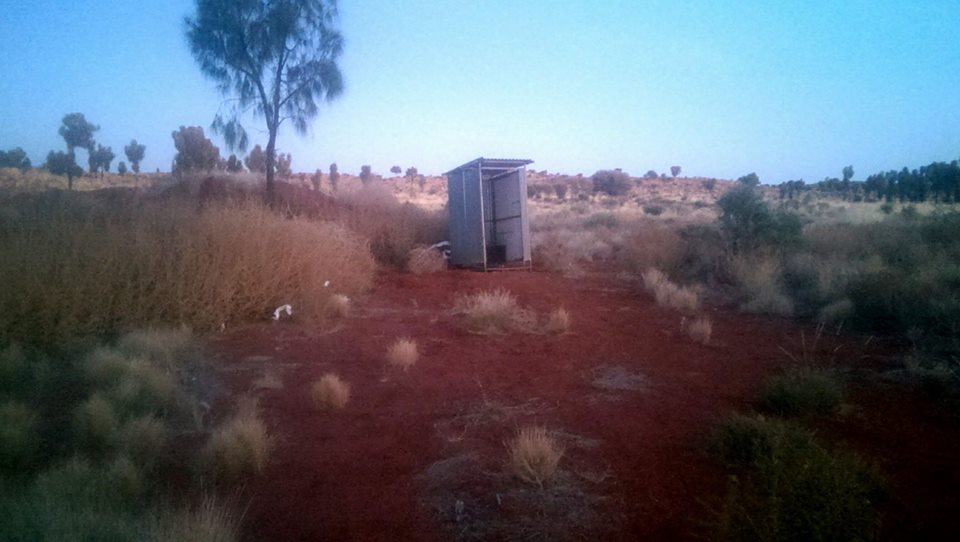
Bush camp toilet!
Dinner consumed and a few glasses of wine drunk, and it was time for bed ahead of an early start tomorrow. Here came one of the things that I was most excited about for this trip; sleeping out on the bush floor in a swag under the stars. A swag is probably best described as a big canvas sleeping bag. You place your sleeping bag inside it (necessary for both hygiene and warmth – you can rent a sleeping bag from the tour company if you don’t have one) and zip yourself up and slumber out there on the ground. I was worried that it would be too cold, but with my layers plus the fire which continued to burn for a few hours after we’d turned in, I found that I was surprisingly cosy. Sleeping out like this in the middle of the outback, with no electric lighting, no street noise and no tent was a phenomenal experience. The stars were so thick that they resembled a blanket across the pitch-black sky. At one point in the night I opened my eyes and saw a shooting star. The only sounds were the crackling of the fire and the occasional howl of a dingo. I’d never been anywhere so utterly isolated before.
I slept well and didn’t wake again until Connor gently roused us early the next morning with pots of coffee and tea brewing over the newly-revived fire. Few experiences in my life have been more serene than watching the sun rise over the red scrub in the middle of nowhere, tin cup of coffee in hand.
As special an experience as the bush camp had been, we were all feeling a bit grubby from the lack of washing facilities, so the first stop for today was at Ayers Rock Campground where we would be staying that night, to avail ourselves of the hot showers, flushing toilets and powerpoints to charge phones and cameras (not that there was any phone signal out there!). This was quite possibly the best shower of my life (rivalled only by maybe the first hot shower I located after four weeks of cold showers in the Philippines, or the first shower after an Australia to England plane ride)! Then it was onwards to Uluru-Kata Tjuta National Park, which spans an area of over 300000 acres, with the two rock formations of the name positioned around 30 kilometres from each other.

First glimpse of Uluru, from a hill at the campground.
We began with the less well-known of the two, Kata Tjuta (also known by its European name of The Olgas). In aesthetic terms, for me this was far more spectacular than its famous counterpart. Its 36 ancient and sacred domes of rock make for a landscape which looks like something out of a science fiction movie. Like yesterday, there were some steep climbs in the sun, but we were thoroughly rewarded by views of valleys and the “Many Heads” (the meaning of “Kata Tjuta” which comes from the Pitjantjatjara language) which can be seen for miles across the flat desert plains.
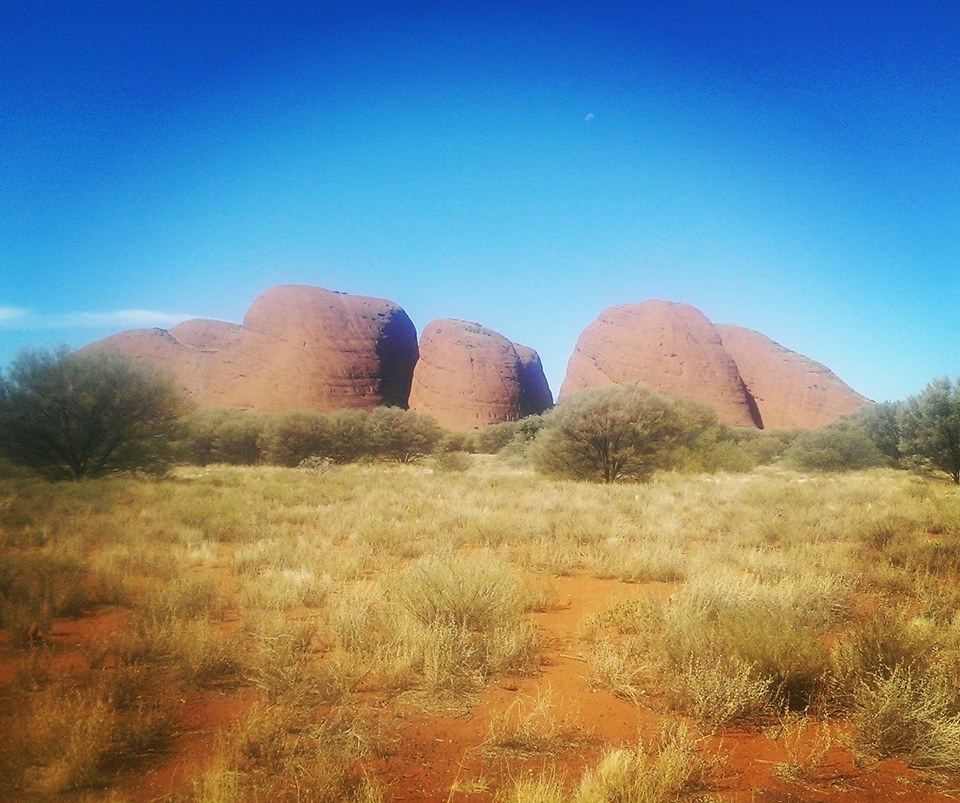
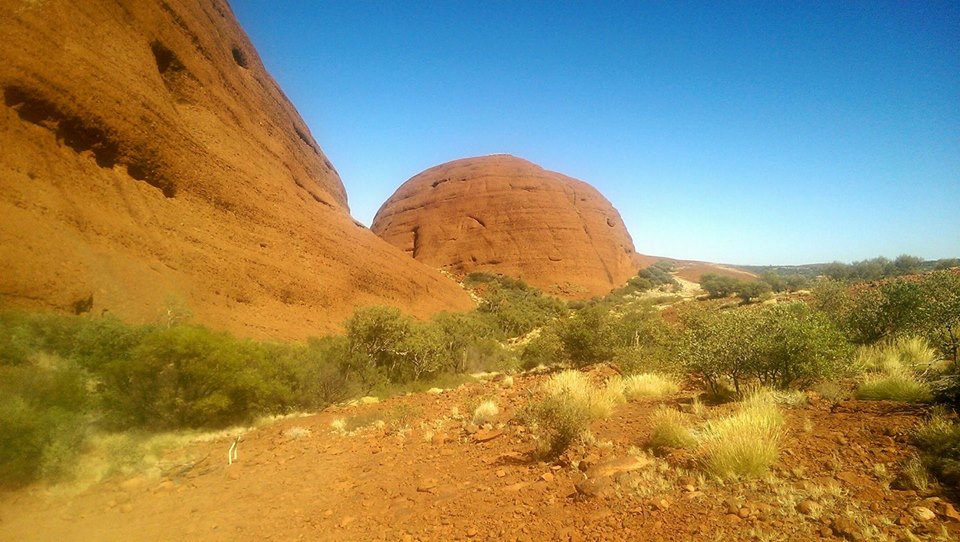
Later that afternoon we headed out to the other section of the park to visit the Aboriginal Cultural Centre which provided an excellent history of the area, and an overview of some of the Dreamtime stories around the creation of Uluru. Connor led us to the base of the rock to point out some of the ancient cave paintings that could be seen there, before driving us to the sunset viewing point to get some photographs of the sun going down over Uluru while he prepared a stirfry dinner for us.

Aboriginal cave paintings at Uluru
As beautiful as the view was, the sheer number of other people there was fairly distracting – it seemed that every single tour group in the area was doing the same thing, and some of the fancier tour companies were even setting up tables with champagne for their groups. It was a sheer contrast to the silence of the bush last night, and a bit of a jarring one.

Uluru at sunset.
We had a far more peaceful experience of Uluru early the next morning however. After another night sleeping out under the stars in our swags, we were headed off to complete the walk around the base of the rock while the sun was rising. Connor, with his vast experience of the area, dropped us off at a point on the walk where he guaranteed that we would reach the best views of the rock just as the sun was coming up. Because we weren’t starting at one of the usual spots, we encountered few other people during the first part of the walk, and Connor had been absolutely correct with his positioning – we were treated to a glorious display of the rock glowing red as the sun revealed itself.
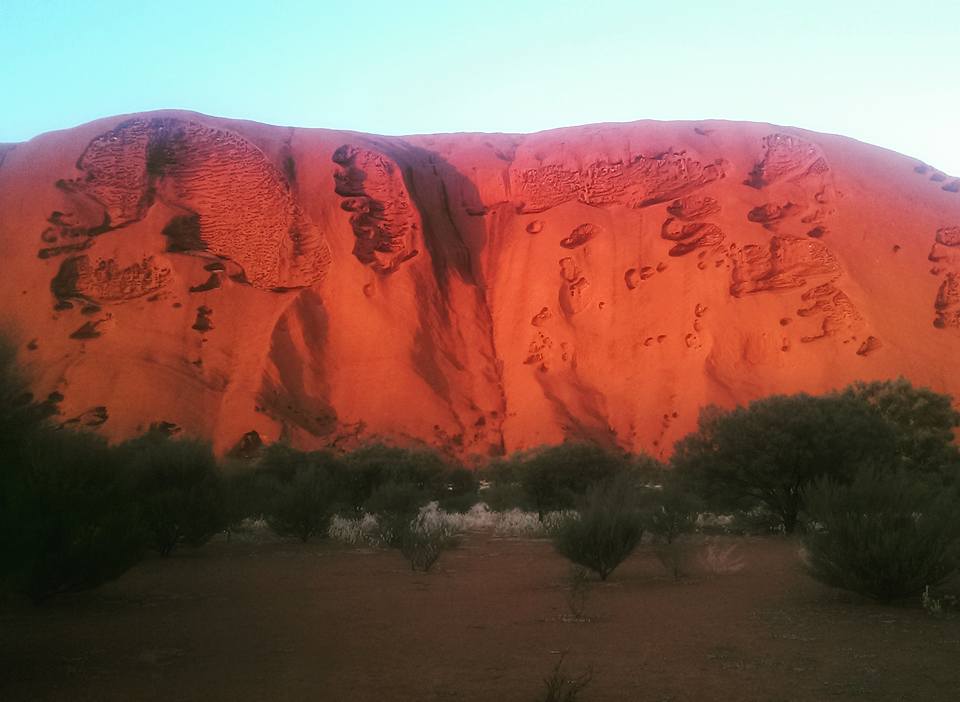
Sunrise at Uluru
Uluru had the air of a very old and very special place about it. It was a privilege to visit, but I was disappointed to see several other tourists abusing that privilege, taking pictures of areas which are particularly sacred and which visitors are respectfully asked to not photograph, and climbing to the top of the rock despite the signs asking, again, respectfully, that you do not climb. Climbing Uluru, happily, will be banned this year, but it saddens me that people cannot be trusted to respect sites such as this one, whether through ignorance, a sense of entitlement, or sheer lack of empathy or manners.
My journey to the heart of Australia was probably the highlight of my two years of living and travelling in the country. The Red Centre is magical, wild and humbling in its vastness and emptiness. I would encourage anyone visiting Australia to include it in their itinerary – but I would ask you to do it in a safe and respectful way.

Enjoyed this post? Pin it for later!

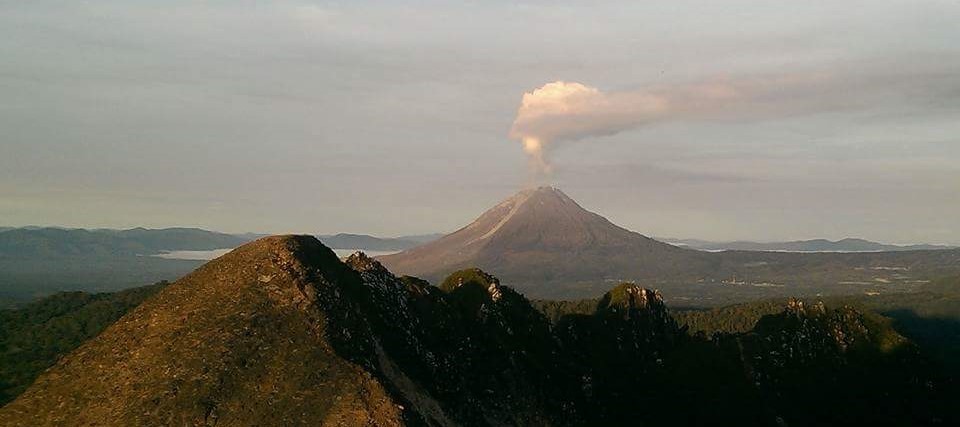
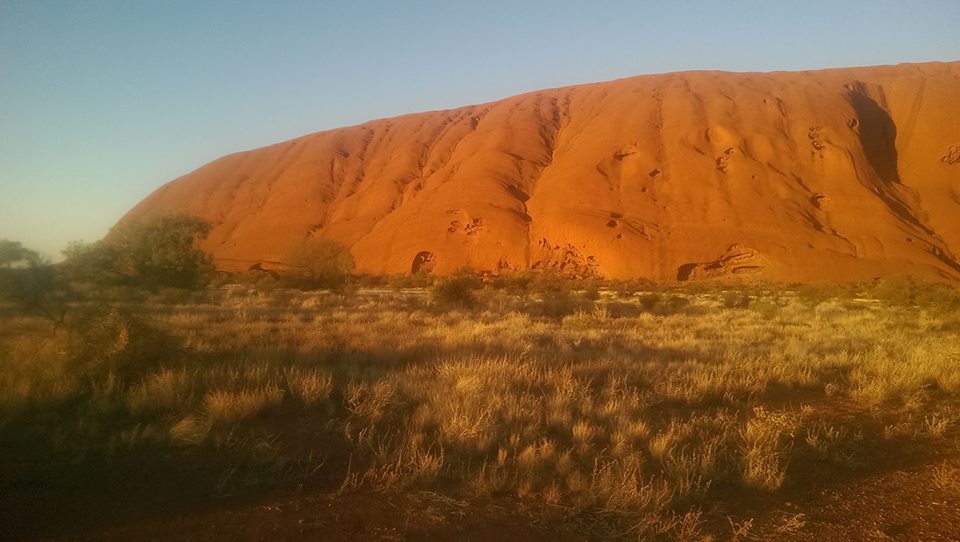


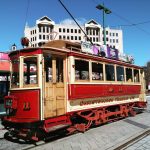
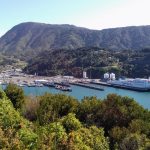
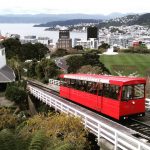
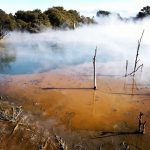

What an experience! My only regret after living in Australia for our one-year working holiday visa is not visiting the outback! But we opted not to do our farm work and the country is so big, as you know, it’s impossible to see everything! One day I’ll see Uluru but I’m very thankful they’ve now banned climbing of the rock!
I’ve ALWAYS wanted to go visit Uluru! I lived in Australia 2016 but never made it in there. I’m really hoping to do so soon!
I used to work in the Uluru-Kata Tjuta National Park and was frankly appalled by the people that used to insist on climbing against the wishes of the traditional owners. It was our job to keep people safe, so we would close the climb if there was any bad weather in the area, because it was a huge safety concern, obviously!
Just about every time I had to close or delay opening the climb, I’d have some tour guide, with a group of wanna-be climbers, arguing with me that I’d misread the radar because they couldn’t see any signs of the bad weather coming in. It was the most frustrating part of an otherwise awesome job.
I’m glad the workers don’t have to deal with that anymore and that the Anungu wishes are finally been respected. There’s so much more to see around the base, like caves and waterholes. The waterfalls after rains are amazing!
Thank you so much for reading and taking the time to share your insight, Kez…I can imagine it must have been so frustrating!
I really loved the way you told your journey. I felt like I was back in the Australian desert. It’s one of my favourite places. And definitely happy that they’ve finally banned the climb.
Lovely post! I absolutely loved the Red Centre when I went too. I did the same route but the other way around. I’m also very happy that they have finally banned climbing Uluru!!
Oh my goodness. I live in Victoria and haven’t seen the red, baron vastness of central Australia that you set out to see. I’ve literally just said to my Aussie partner, who has also not been, we’re going! Thanks for the inspiration!
Pingback: Coral reefs and emus: exploring Exmouth, Western Australia - The Imagination Trail
Pingback: Two days to Darwin: reaching the tropical capital - The Imagination Trail
Great detailed post. What a beautiful red glow on the rocks at sunset and I would love to visit the kangaroo sanctuary!
Beautifully written,extremely descriptive and an absolute pleasure to read. What a great book your adventures would make, it would be compulsive reading.
Thank you!